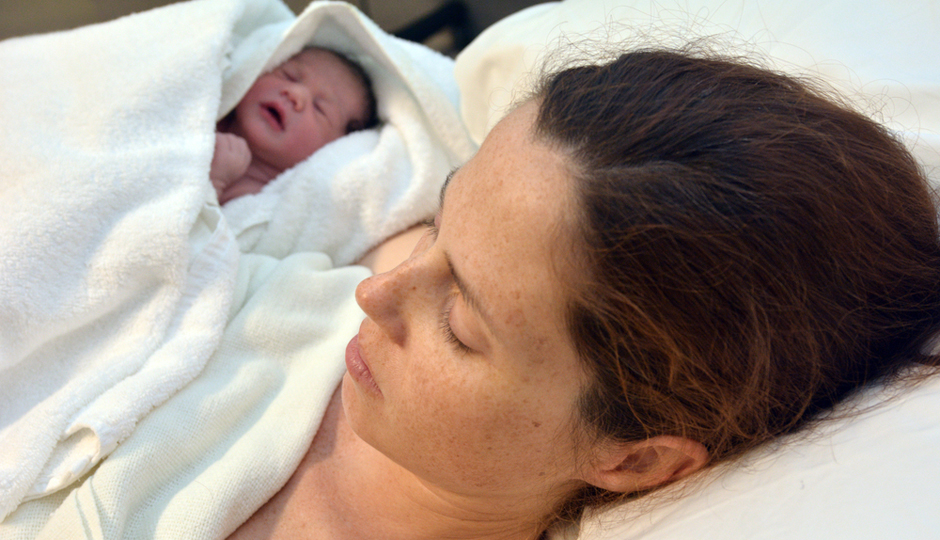The Evolution of Birthzilla: Why Women Want a Crowd in the Delivery Room

Shutterstock
First came Bridezilla—the self-obsessed center of attention who pitches fits if every single detail of her wedding day isn’t to her liking. Then, heaven help us, came Birthzilla—the mom-to-be who had to have her husband and her mom and her mom-in-law and her doula and all her besties gathered together to witness the miracle of birth. Pure silliness, right? How can doctors and nurses do their jobs with all those people crammed around the bed?
Not so fast. According to a professor at the University of Delaware, the way boomers gave birth—alone with their physicians in sterile operating rooms—is the evolutionary outlier, and the cocktail party in today’s birthing suites is a return to our roots.
Karen Rosenberg is a paleoanthropologist, which means she studies the fossils of humans and their ancestors—“the intersection of anthropology and evolution and prehistory,” she explains. Her dissertation was on a difference between the pelvises of Neanderthals and humans; today, her work focuses on the birth canal. “I really like studying it,” she explains. “It makes it easy to understand how natural selection happens.”
The human birth canal, Rosenberg says, is convoluted because five to seven million years ago, we decided to walk upright instead of on our hands and feet. As a result, our pelvises changed shape. An ape’s birth canal is a straight chute; a human’s is curved: “Babies twist and turn as they pass through, with the biggest axis of the head constantly trying to find the biggest axis of the birth canal.” When human babies emerge, they’re facing in the opposite direction from the mother, who thus can’t easily reach down and offer assistance. And human newborns are helpless; unlike a baby chimp or ape, they can’t grab onto their mother’s fur and help deliver themselves.
There isn’t a lot of evidence about how other primates give birth in the field, Rosenberg says, but what there is shows that the mother goes off by herself when she goes into labor, just as most animals do: “They don’t want to be around their own species or predators.” There also isn’t a lot of evidence about how our distant ancestors gave birth. But there are clues. Remember Lucy, the famous Australopithecus fossil from Ethiopia? Rosenberg says Lucy’s “beautifully preserved” pelvic bones show she had evolved to walk upright. Her birth canal, however, was shaped differently from ours. It was broad and flat—“optimal for what she did, which was give birth to babies with much smaller brains than ours.”
The brains of our ancestors kept growing and evolving, making for a very tight fit through that curved birth canal. It’s this one-two punch—helpless babies with big heads—that makes our offspring so unusual. Rosenberg calls it a “fatal combination.” Because we’re born at a relatively early stage of development, we need to be carried around and protected. Rosenberg mentions 20th-century anthropologist Ashley Montagu, who said that human babies have “exterogestation”—they continue to develop like a fetus even after they’re born. In order for them to do so, Rosenberg explains, “We create a cultural womb for them,” swaddling them in blankets, toting them in carriers, tying them to cradle boards.
And we’re able to do that because we don’t go it alone—because we share food and the care of children and, yes, the birth process. “Absolutely, humans evolved to give birth in a social context,” says Rosenberg. “It happened across cultures, over a long time.” The American way of giving birth is the oddity. “When I was born,” says Rosenberg, “it never would have occurred to my father to be present. Now, it’s commonplace for the father to be there.’ In other countries, people gather for childbirth, she notes: “It’s only here that doctors convinced us to be isolated from our emotional support.”
Now, though, the medical profession itself is evolving, and allowing more people to be present for births. That’s not because it makes it easier for the doctors; it’s because of consumer demand. But there are proven benefits. Studies show that women who have doulas, not for medical aid but simply to support the mother, have lower rates of C-sections and other forms of intervention. “The mothers seem to need and get them less,” Rosenberg says of such interventions, “because their emotional needs are being met. They can do what they need to do more effectively.”
Paleoanthropology, Rosenberg says, is “both about the past and about issues that are still important today.” We don’t merely pass on our genes: “It’s not just biology. This is what makes humans interesting. The ability to have and transmit culture—kinship, ritual, language—is part of our adaptation.” Birthzilla, it turns out, is only doing what comes naturally to human mothers. Bridezilla, though—there’s no evolutionary excuse for her.
Like what you’re reading? Stay in touch with Be Well Philly—here’s how:
- Like Be Well Philly on Facebook
- Follow Be Well Philly on Twitter
- Follow Be Well Philly on Pinterest
- Get the Be Well Philly Newsletter


